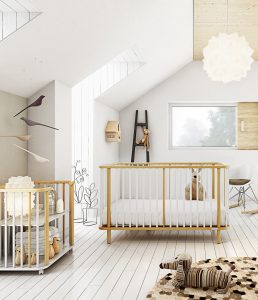
Photo source: Micuna/babyhome
After getting a positive pregnancy test, decorating the nursery is right up there on the excitement scale. There’s nothing like having a baby on the way to rustle up your nesting instincts.
On one hand, the nursery is just a room–traditionally the smallest bedroom in the house. On the other, it’s a room with a viewpoint.
“When you’re creating this environment, you’re showing your love for your child and creating an honor space because you want the best for him or her,” says Angela DeYoung, an interior designer in Franklin, Tennessee. Through the nursery you envision, you might also be reliving the joy of your own childhood.
Still, like weddings, baby nurseries are big business. Sure, well-wishers can help fund your dream nursery by chipping in for the furniture on your baby registry. But it’s still easy to go all out—as in spending $10,000 or more. (Whoops!)
How to decorate a nursery cheaply?
“Design is a slippery slope and dollar costs can add up quickly,” says Donna Hoffman, former QVC host and founder of The Interior Design Advocate, a site that helps DIY consumers avoid wasting money when furnishing or designing a home. Hoffman equates the thrill of outfitting a nursery to food shopping when you’re hungry. “You’re compelled to overspend,” she says.
If it’s your first baby, you might think, well, it’s my first baby, so I’m just going to splurge. And baby #2? Well, he/she should have it just as good as baby #1, don’t you think?! Don’t get me wrong. These are valid reasons for going all out on the nursery. After all, babies are priceless.
Still, raising them is a pricey proposition. According to the USDA, you can expect to spend at least $233,610 on each child from birth to age 17 on things like housing, food, childcare, education and clothes.
To meet your expenses, which may include paying student loans, have reserves for emergencies and saving for retirement and your baby’s college fund, it pays to strategically cut corners. The nursery is a good place to start.
These smart steps can help you stretch your nursery decorating dollars—and lots more. Consider this post your baby nursery decorating blueprint that can help save your sanity and your budget.
This post contains Amazon Affiliate links to products Babyproductsmom recommends, at no cost to you. As always, thanks for your support!
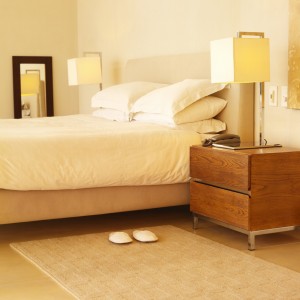 Step 1: Take a good look at your bedroom
Step 1: Take a good look at your bedroom
During your baby’s first six months to a year, your bedroom should, ideally, double as a nursery. Rooming in with your baby in a crib or bassinet (but not co-sleeping), reduces your baby’s risk of sudden infant death syndrome by 50 percent, according to the American Academy of Pediatrics. Where will you put the bassinet or crib? How much space you have in your bedroom can determine which type of baby bed you get initially. Although you can use a crib from day one, you’ve got options, such as: Newton bassinet (roomy!), Halo BassiNest Swivel baby bassinet, a travel crib like the Baby Bjorn Travel Crib Lite or the Snoo smart bassinet.
For larger spaces or tight budgets (as in–skip the bassinet)
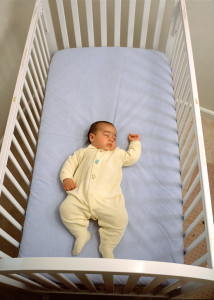
Full-size crib: With this nursery strategy, you skip the bassinet and go straight to the crib in your bedroom. Warning: Your baby will look tiny in a crib at first but that’s okay. You’ll move the crib into the nursery when your baby is 6 months or older. Keep in mind cribs sold in the U.S. are federally regulated; fullsize cribs must be a standard size (28? wide and 52 3/8? long, plus or minus 5/8?). If your budget is tight, a crib like this one will get the job done. And don’t forget the crib mattress. Go with a basic Greenguard-certified foam mattresss like this one. Compared to an innerspring crib mattress, a firm foam is lighter, easier for crib sheet changes.
Keep in mind that bare is best. Skip the bumpers, sleep positioner, blanket, pillow, stuffed animals. In the crib, just a tight-fitting crib sheet is all you’ll need. (Feel free to use the crib sheet as a decorating focal point.) Dress your baby in a swaddle or sleep sack or warm jammies instead of using a blanket.
What’s sleep solution is safest–a crib, bassinet or travel crib? All of them are fine. “It’s whatever works best for the family,” says Rachel Y. Moon, MD, a professor of pediatrics at the University of Virginia School of Medicine and co-author of 14 Ways to Protect Your Baby from SIDS.
Your overall starter nursery strategy:
Put a travel crib, bassinet or full-size crib right next to your bed along with a changing table or some sort of changing table set-up for middle of the night diaper changes. After six months or so, move your baby to a full-size crib in the nursery or, if you started with a crib in your bedroom, you can move the crib to the nursery.
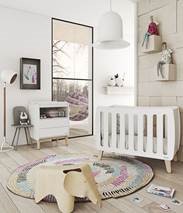
Photo source: Micuna
Step 2: Planning the Nursery–Big Picture
Before diving in to outfitting your baby’s actual nursery, ask yourself the first big-picture question: Will this room be a dedicated or a convertible nursery?
Dedicated Nursery—the details
A dedicated nursery stays that way as long as you have babies in the house. The room will be used for baby #1 and for all babies thereafter. If/when baby #2 etc. comes along, the new baby takes over the nursery and bumps out his/her older sibling into a big boy/big girl room, and so on. A dedicated nursery won’t convert to a big boy/big girl room until your last baby becomes a toddler. Depending on the size and spacing of your family, a dedicated nursery could stay in baby mode for a decade or more.
Convertible Nursery—the overview
A convertible nursery, on the other hand, grows with your child. It starts out as a nursery then converts to a big boy/big girl room when that baby becomes a toddler. Baby #1 starts out in that room and stays. If/when baby #2 comes along, he/she gets his/her own nursery.
Your answer to the dedicated versus convertible nursery question provides the framework for your nursery and other decorating decisions. When you’ve got the big picture, you can avoid costly mistakes, such as spending $5000 on a hand-painted mural for baby #1 in a dedicated nursery you later decide wouldn’t work for baby #2.
What about house guests?
When planning your nursery and the furniture you’ll need, consider all the bedrooms in your home and their use, including what you’ll do with overnight visitors. If baby #1 gets bumped into a big boy/big girl room when a new brother or sister comes along, for example, that child’s new room could double as a guest room, if you buy a queen-size bed instead of a twin bed.
Having a big boy/girl bedroom double as a guest room is a tactic designer Angela DeYoung used when her kids were little. “By the time both my kids were 3 years old, they already had queen-size beds,” she says. For safety, she just added a bed rail to the queensize bed. Guests can take over your child’s big boy/girl room and your toddler/preschool-age kids can temporarily camp out in your room in an inflatable toddler bed. I can vouch for this one, the Hiccapop inflatable toddler bed.
Tip: If you plan to put a queen-size bed in your child’s big boy/big girl room, don’t worry so much about buying a convertible crib–a crib that, with a conversion kit (usually sold separately) and a full-size mattress (sold separately as well), transforms into a toddler, twin or full-size bed. Most convertible cribs don’t convert to a queen-size bed. Note: If you want to buy a convertible crib and the conversion components are sold separately, buy the conversion components at the time you buy the crib, just so you have them. Cribs and their respective conversion components become unavailable for many reasons.
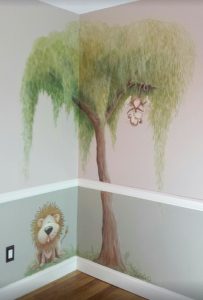
Handpainted mural by Annette Dostaler
Second big-picture question: Will my baby’s nursery have a theme?
Once you have an idea of which nursery configuration you’re after (dedicated vs convertible nursery), it’s time to consider whether your baby’s nursery will have a decorating theme or not. Popular nursery trends include woodland, nautical, flowers and Disney and other characters, such as Winnie the Pooh. (Here are more classic nursery themes for ideas.) If you choose a theme, filter everything you buy for the nursery through your theme lense, as in “Does this style crib fit with my woodland-themed nursery?”
Your theme can be general, such as monkeys, trains, geometric, clean and contemporary, retro, Victorian, black and white, etc. Or skip the theme concept and just be eclectic. You can find design inspiration in a crib skirt, a rug or artwork first, then spin your entire room around it.
Go ahead and turn to Pinterest or celeb nurseries for nursery theme inspiration. But feel free to be uniquely creative. “Celeb nursuries are just suggestions,” says DeYoung. “Those are their dreams. What are yours?”
If you have a color you love, go for it. Want to do pink and poofy? Go ahead. “One client was having twins, a boy and a girl. She did her nursery in shades of cream with splashes of peach and gray,” Hoffman says. Safety in the nursery should be your main concern. But otherwise, there are no rules. “If there’s any room where you can push your fantasy, it’s a child’s room,” Hoffman says.
If you’re thinking about painting a mural, here’s excellent artsy advice for working with a muralist.
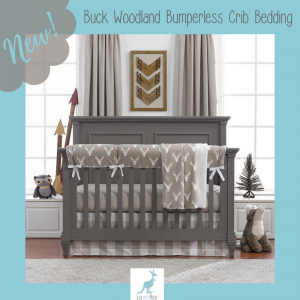 Nursery Decorating Guidelines
Nursery Decorating Guidelines
Convertible nurseries: from baby to big boy/girl room
Choose a convertible crib. “It’s a great option for young families,” Hoffman says. Rather than buying a crib and a twin or full-size bed within a few years of each other, you’ll simply morph the crib into the next-stage bed, with a conversion kit and full-size mattress (sold separately).
“Taking the long view in design will come back to reward you,” Hoffman says. Buying a convertible crib can be less expensive in the long run. Plus, when your crib days are over, you’ll know exactly what to do with the crib: Convert it into a toddler or full-size bed.
Don’t go into lockdown baby mode. With a convertible nursery, having the flexibility to morph the room into the next stage is key because the room will grow as quickly as your child does. But if you want to baby it up, keep babyish items off permanent surfaces. Choose gender-neutral colors for the floor and walls. In other words, you might want to think twice about babyish pink or blue carpet or wall color.
Ideally, for a convertible nursery, you should be able to lift anything babyish, such as artwork, out of the room.
Safety check: Remember, bare is best. Don’t use bumpers, blankets, pillows, sleep positioners or stuffed animals in the crib.
Dedicated nurseries: A room that stays in nursery mode indefinitely
Go baby crazy if you want to. If the room will be a dedicated nursery, you can babyify it all you want and not worry about having to change the décor anytime soon. If you’re in to classic boy/girl stuff though, just make sure all gender-related décor isn’t permanent in case you have a different gender baby next time.
Think blank slate. Since this room will need to work for all babies down the line, neutral colors will serve you well. “Gray is popular for nurseries because you can accent it any way you want,” says Caroline Eager, president of the Liz and Roo fine baby bedding. Think gray or taupe crib bedding (crib sheet, blanket for use outside the crib only and crib shirt) and neutral walls, such as white, with pops of colorful accessories, such as gray and pink, aqua, taupe or coral, which are popular color combos for girls, and gray and navy, red or a lighter gray, which are trending for boys.
Don’t worry about buying a convertible crib. Cribs that convert to toddler, day bed or full-size bed are popular. There’s lots of selection in the convertible crib category. Still, since a dedicated crib will be used in crib mode indefinitely, you can zero in on cribs that don’t convert if you want to or buy a convertible crib but skip the conversion kit. But when your crib days are over, you’ll have to ask yourself: What are we going to do with the crib? One answer: Scout around in your area to find a place to donate it, if it’s in excellent condition and hasn’t been recalled.
Step 3. Select nursery furniture
After you’ve decided on the type of nursery you want (dedicated versus convertible), it’s time to go furniture shopping. In fact, it’s best to buy nursery furniture first, then your baby bedding and then select wall paint or wallpaper.
This shopping sequence minimizes do-overs, as in painting the walls mint green first (like I did), then trying to find nursery accessories to go with the wall color. Who knew what an impossible task that would be? (The room got repainted lime green, which worked much better.)
Okay, let’s drill down some more.
When selecting nursery furniture, shopping in this order can make your life easier: Select the crib first, then all the rest–the dresser, changing table and glider.
What furniture do you put in a nursery?
Nursery Furniture Secrets
Before reading any further, psst! Here’s a little secret about baby furniture in general: Unlike furniture made for adult spaces, such as a dining room table or a sofa in your living room, most baby furniture isn’t made to last. It’s true!
“For the most part, juvenile furniture doesn’t feature the manufacturing processes that you’d find in ‘better’ or ‘best made’ furniture,” says Hoffman. Because of potential quality issues, such as peeling paint and drawer hinges that come off, most interior designers will only work with best-made nursery furniture manufacturers (a fraction of the market).
So, if you choose to work with an interior designer, expect to pay a premium for nursery furniture. Even still, the furniture will likely not be “better” or “best made.”
Even if you pay top dollar, you can find yourself with chipping paint, nicks in the wood, hardware that dislodges and other quality issues. After a couple of years of use, your baby’s nursery dresser drawers might come undone, for example, preventing you from opening or closing the drawers (been there). Bottomline: Buy the best quality nursery furniture you can afford, but don’t break the bank. It’s not worth it. In other words, compared to say a $500 crib, a $100 to $300 crib is likely to do the job just fine.
Where to Shop: Online vs brick and mortar store
In terms of where to shop, ask yourself: What level of customer service am I comfortable with? Baby furniture can be tricky. Even if you buy nursery furniture from a baby boutique, parts can be missing or broken during shipping (it happens all the time). Then, there’s assembly, which can be more involved than you anticipate.
Still, consider shopping at an actual store, not online. In other words, “use a retailer with a door presence in your town,” Hoffman says. That way, if there’s a problem with the baby furniture you select, you have an actual person or store you can turn to. They may even be able to help you assemble the furniture too (though Amazon can do that too. Check out their crib assembly service). As someone who assembles cribs often because I rent baby gear as a BabyQuip Quality Provider, serving Connecticut, it’s a project. Even if you’re handy, plan to spend two hours to do a thorough job.
“Is There Room in the Price?”
Another advantage to shopping for nursery furniture at a local baby boutique is that the proprietors more have more price leeway. So be sure to ask: “Is this your best price?” (It’s commonly done.) Ask about the return policy too. Specifically, you want to know: Can I return this furniture for any reason? And, if you can return it, is there a restocking fee?
One new mom called Babyproductsmom complaining that the baby furniture she just bought from a local baby boutique smelled like new furniture even though they told her it wouldn’t. Concerned about volatile organic compounds (VOCs; more on those in a jif), she wanted to return everything–the crib, dresser and glider. The retailer told her that odor wasn’t a good enough reason to return the merchandise. He wouldn’t take the furniture back without charging this customer a restocking fee that was half the price of the furniture. Needless to say, she kept it, but not happily. I told her to just air it out. (See How to Get Rid of that New Furniture Smell, below.)
Buying the Crib: Features to Consider
- The look. Crib styles range from traditional (carved spindles) to modern (sleek, clean lines). Convertible cribs often have a headboard—the backside is higher than the rest, which can serve as the headboard to a full-size bed. As you’re considering cribs, ask yourself: Does this crib look fit with the style of the nursery I’m envisioning?
- Color. Cribs come in wood, metal (such as painted iron) and acrylic (translucent plastic). Popular colors range from brown, black and gray to white, clear and natural, and painted cribs in colors such as yellow and blue. Just fyi–white cribs are the most popular, commanding 50 percent of the market.
- Stationary sides. Any crib you’re considering should be made after June 2011, when federal crib safety standards were updated, such that all cribs sold in the U.S. must have stationary sides. In other words, don’t buy a used crib with a drop side (a side that moves up and down), even if you find it at a tag sale for next to nothing. Also, say “thanks, but no thanks,” if someone tries to give you a drop-side crib. If a crib is circa 2011 or before, it’s potentially dangerous. Bottomline: The crib you buy should be a solid piece of furniture, with no moving parts.
- Recessed hardware: It’s always a plus when the screws and bolts that hold a crib together are inset into the wood. It’s peace of mind when there’s no protruding hardware that could potentially scratch your baby or catch baby’s clothes. It’s a cleaner look too.
- Greenguard certification. Because babies are still growing and developing, they breathe more air for their size compared to adults. Consequently, they’re at higher risk for inhaling volatile organic compounds (VOCs), fumes that emit from products made with formaldehyde and other chemicals.
 We spend 90 percent our time inside where air pollutant levels can be 2 to 5 times higher than they are outside, according to the EPA.
We spend 90 percent our time inside where air pollutant levels can be 2 to 5 times higher than they are outside, according to the EPA.
VOCs have been linked to asthma, allergies and lung infections in infants. Children exposed to elevated levels of VOCs are four times more likely to develop asthma.
One way to limit VOCs is to buy a crib and mattress that have been Greenguard certified. (Look for the Green seal.) A Greenguard certified crib and crib mattress have been tested by the Greenguard Environmental Institute and screened for over 10,000 airborne chemicals and has passed Greenguard’s rigorous standards for indoor air quality. They’re free of VOCs. Greenguard is a voluntary program.
Safety Check: How to Get Out that New Furniture Smell
If you can’t buy a crib and a mattress that’s Greenguard certified for some reason, air them out for two weeks before using them, somewhere where there’s lots of air circulation, such as in a room with open windows. (That advice applies to all new baby furniture with a new furniture smell.) Good to know: VOCs peak within the first 24 hours after a new product is taken out of the package, says Marilyn Black, PhD, the founder of the Greenguard Environmental Institute. In fact, 90 percent of chemicals “offgas” within 24 hours.
Put a fan on the floor to move the air and push it out the windows. Ventilation is key. But don’t air out a crib or a crib mattress in the garage; there’s a potential for cross contamination—for example, if you store oil or gas there. If the new smell doesn’t dissipate within two weeks, that’s an indication that strong chemicals were used in manufacturing and that it may take much longer for them to dissipate.
Crib Recommendations for Convertible and Dedicated Nurseries
Every crib listed here (below) is Greenguard certified except for those with a star/asterisk. Babyproductsmom included some cribs that aren’t Greenguard certified because they’re high quality and good value.
A note about cost: How much to spend on a crib can depend on how high style you want to go and the potential size of your family. If you’re only planning on having one child, for example, an inexpensive crib will do the job. Why invest $500 to $1,000 in a crib if you’re only going to use it for two to three years?
Keep in mind that the crib mattress, mattress pad, fitted crib sheet, and crib skirt (optional) are sold separately.
Good Value Cribs ($115 to $350)
*Fisher-Price cribs: All Fisher-Price cribs convert to a toddler, daybed and then, a full-size bed (full size mattress and conversion kits sold separately). All Fisher-Price cribs are manufactured by Bivona, which licenses all cribs sold under the Fisher-Price label. They’re not Greenguard certified though.
The Fisher-Price *Newbury crib is a top seller. Here are more Fisher-Price cribs to choose from.
*Union 3-in-1 Convertible Crib: You can buy a good, safe crib around $100 and this one proves it. The Union 3-in-1 comes in five colors: Espresso, Grey, Lagoon (blue), Sunshine (yellow) and white.
*Dream on Me Aston 5 in 1 Convertible Crib: This crib sells for around $200. It’s another great value buy.
All cribs (below) are Greenguard certified:
Nursery Smart
DaVinci
DaVinci cribs convert to a toddler bed and full-size bed (3-in-1, as in crib, toddler bed and full-size bed) or toddler bed, day bed and full-size bed (4-in-1).
Jenny Lind 3-in-1—classic spindle crib, with wheels. Some DaVinci cribs come with a toddler conversion kit; the full-size conversion kit is sold separately.
Meadow 4-in-1—solid back and headboard.
Piedmont 4-in-1—spindle crib with under drawer. Comes in three colors: Espresso, slate (gray) and white.
Clover 4-in-1—Classic spindle crib
Other Greenguard certified DaVinci cribs to choose from include:
Richmond 4-in-1
Glenn 4-in-1
Grove 4-in-1
Laurel 4-in-1
Perse 4-in-1
Brook 4-in-1
Porter 4-in-1
Thompson 4-in-1
Autumn 4-in-1
Emily 4-in-1
Parker 4-in-1: Comes with a natural finish and under drawer.
Baby Mod Bella 4-in-1
Highland 4-in-1
Kalani 4-in-1: Available in seven colors: Cherry, chestnut, Ebony, Espresso, Gray, White and Honey Oak.
Morgan 4-in-1
Jamie 4-in-1
Jayden 4-in-1
Flora 4-in-1
Asher 3-in-1
Connor 4-in-1
Taylor 4-in-1
Mid-range cribs: $350 to $500
Babyletto
This modern crib manufacturer is high style, but still affordable. Some Babyletto cribs include the toddler bed conversion kit (fullsize conversion kit sold separately).
Choose from:
Babyletto Skip 3-in-1
Babyletto Mercer 3-in-1
Babyletto Hudson 3-in-1. This crib converts to a daybed/toddler bed and has a matching changing dresser (dresser with built in changing table, which are sold separately). It’s a best seller. Comes in six colors: Espresso, white, espresso/white, grey/white, washed natural and grey.
Babyletto Modo 3-in-1
Babyletto Sprout 4-in-1 crib: Converts to a twin bed, then a full-size bed. Conversion kits sold separately.
Babyletto Gelato 4-in-1 convertible crib: With this crib, you can swap out the feet for a subtle style statement; additional feet colors are available in spring yellow or cool mint (colored feet sold separately).
Babyletto Scoot 3-in-1
Babyletto Lolly 3-in-1
Million Dollar Baby Classic
Liberty 3-in-1 convertible crib
Karla Dubois
Karla Dubois Oslo Crib: modern design; includes under drawer for storage. The head board can be used for a full-size bed. Toddler bed guard rail sold separately.
Getting up there: $500+ Cribs
Oeuf
Sparrow crib in walnut, slate, petal and birch
Baby Appleseed
Davenport Convertible Crib
Stratford
Chelmsford
High end and High Style Cribs (over $1000)
Nursery Works Novella crib: It converts to a daybed, toddler bed and a reading nook. Conversion components sold separately. Includes specialty details, such as steel feet with brass plating.
Nursery Works Vetro: It’s made of dark yet translucent acrylic. Since it launched in 2013, this see-through crib has been selling well, says a company representative.
RH Baby & Child
Tulip Juvenile Crib
All Tulip Juvenile Cribs are Greenguard certified.
Natart
A popular one: Avalon by Natart. “We use this crib for Liz and Roo’s photo shoots,” says Liz and Roo’s Caroline Eager. “The Avalon is a creamy white that looks beautiful with everything. We so get so many calls asking ‘What’s that crib? I want to buy it!’”
Step 4: Select the crib mattress
Crib mattresses are typically sold separately. Babyproductsmom is a big fan of firm Greenguard certified crib mattresses. You can find Greenguard certified crib mattresses here.
More Baby Furniture Secrets You Need to Know:
Bundling can be a bargain. Buying nursery furniture as a set–a nursery collection–can look nice in the baby’s room. If you decide to go that route, ask about bundled pricing, such as three pieces for $1000. Bundling can be a good deal.
Cribs and their conversion kits get discontinued. Repeat–buy all conversion kits when purchasing your crib, even if you’re not sure if you’ll be converting the crib to a toddler or full-size bed. It’ll add an extra $100 to $300 to the cost, but at least you’ll for sure have it for later.
Crib placement is important. Think about where you’ll put the crib in your baby’s nursery. Room placement can be a factor in deciding which style of crib to buy. If you want to float the crib in the middle of a large room, for example, look for a crib without a headboard, one that’s even on all sides. This oval crib (below) looks good as a standalone, don’t you think?
Step 5: Select Other Baby Furniture
The dresser
Baby furniture dressers especially have a way of looking high quality, but not holding up too well over the long. Even if you pay top dollar, drawers can fall off their tracks; drawer bottoms can come unglued. For that reason, it’s a good idea to venture off the baby furniture grid and invest in a dresser that’s not part of a nursery collection.
By shopping for a non-nursery dresser, you have a better chance of buying a dresser that your child could potentially use he/she leaves for college or use in another room. “A chest of drawers is the most versatile piece of furniture you can have in your home,” DeYoung says. Or, shop your house for a dresser that needs a new purpose or scout out the selections at antique stores and refinish the dresser yourself. Used furniture—anything over two years old—is no longer likely to off gas. If you buy used furniture and decide to spruce it up, use no-VOC paint.
But keep in mind that the dresser you select should be low enough so you can double it as a changing table. In otherwords, go ahead and skip the changing table and install a changing pad on top of a dresser and call it a day.
Safety Check: Securing Tall Furniture
It’s imporant to secure tall baby furniture such as a dresser and bookcase to the wall.
According to the CPSC, one child dies every two weeks when a TV, furniture or appliance falls on him/her. More stats:
25,400: Number of children injured from furniture tip-overs annually
45: Percent of furniture tip-overs that occur in the bedroom
70: Percent of TV tip-overs
26: Percent of tip-overs that occur with dressers and tables
New furniture is sold with brackets. Follow the instructions on the package to install them. If you’ve purchased older or used furniture, you’ll need to buy brackets (available at hardware stores). These tips can help with installation. Install brackets/bolt a tall dresser and bookcase to the wall even if you don’t think your child will be a climber, you’ve installed safety latches on the drawers, and you’ve purchased your furniture from a reputable store. If you need assistance with installation, call a professional childproofer.
The glider
A glider can be a nice addition to a nursery. Trending: Wide gliders; gliders that are extra wide so you can read to your toddler (your baby in no time) and sit side by side comfortably in the chair. But don’t think you’ll use the glider after your baby days are long over (to justify blowing your budget). You won’t. “Nursery gliders tend to look silly in other rooms in the house,” DeYoung says. “Most people end up trying to sell it.”
Consider pint-size pieces
When outfitting your nursery, think of it from your child’s perspective and consider buying child-size furnishings, such as a child-size upholstered armchair or a child-size chair and table. “Toddlers love to have furniture their own size they can move around,” Hoffman says. Once the nursery converts to a big boy/big girl room and you transform the crib to a toddler or full-size bed, you can move the furniture to a toy room if space is tight.
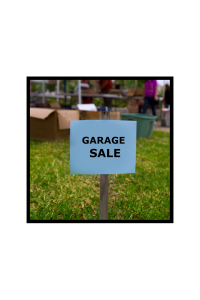 Safety check: Buying used baby furniture
Safety check: Buying used baby furniture
As long as a crib doesn’t have a drop side, which signals that it was made pre-2011, before crib safety standards were updated, it’s probably fine to buy a used crib if it hasn’t been recalled and it’s a solid piece of furniture (no wobbly spindles or loose hardware). But generally, for peace of mind, Babyproductsmom recommends buying a new crib, then reusing it for your next baby unless it gets recalled in the interim. Don’t buy a used drop-side crib, or accept a hand-me down. Nuh uh. Never.
Benefits to buying new stuff
–You know the history of a product and how it has been used.
–You get to assemble it correctly, according to the manufacturer’s instructions (which aren’t missing).
–You get to register the product on the manufacturer’s website and be quickly notified in case of a recall. Cribs are a highly regulated product that get recalled from time to time due to violations of federal safety standards and/or things that happen in everyday use that manufacturers can’t anticipate.
–You know it’s clean. With used upholstered furniture, including an upholstered crib, crib mattress or glider, dust mites can be present (radar: allergies in children susceptible to them).
Step 6: Choose baby bedding
Finally, it’s time select baby bedding. That means buying a tight fitting crib sheet or two, and maybe a crib skirt, for fun. Go ahead and go crazy with colors and prints. Interesting aside: A color that’s surprisingly not popular for nurseries: Yellow. “We have no demand for yellow bedding at all,” says Liz and Roo’s Caroline Eager. At Liz and Roo, you can also buy a matching cover for the changing table pad. They’re also famous for their crib rail covers, which also add a decorative touch. But remember, bare is best. No bumpers (not even the meshy ones), blankets, stuffed animals, pillows, or sleep positioners in the crib.
Bonus: Not buying a crib bumper set can save you hundreds of dollars. If you want to get a pillow—monogrammed pillows are popular–get one for the glider. “It’s cute and great for back support,” Eager says.
Step 7: Choose your wall color or wall paper
Neutral wall colors for nurseries, such as gray and off white, are popular. “They allow you to play with accessories,” says Janene Ferrara, owner of Dalehead Designs in Sayville, New York. Neutrals give you the flexibility to easily change out the bedding and artwork if you want to. Lavenders and blues are also nice paint colors for the nursery because they’re soothing. As a general rule with paint, stick with light shades. “Because paint encompasses a whole room, it can be overwhelming if it’s too dark,” Ferrara says.
To paint the room, use paint with low or zero volatile organic compounds (VOCs) or paint the nursery at least a month before your due date so the room has time to air out.
Paint large samples on the walls and live with them for a couple of days so you can see how light reflects off each color at different times of the day. If you decide to wallpaper the baby’s room, peel and stick makes papering whole walls easier. It’s a plus if the wallpaper is washable.
Step 8: Add wall decals or a mural
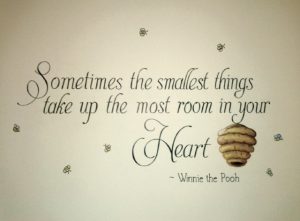
Handpainted mural quote by Annette Dostaler
Key question: Do you use wall decals or paint a mural?
For a whimsical feel, peel and stick wall decals, such as lady bugs, dragonflies, the alphabet and trains are an easy way to add detail to the walls and ceiling. DeYoung suggests placing wall decals in unexpected places, such as along the baseboard. “It’s all about the composition,” she says. Experiment until your design feels right.
If you want to use a peel and stick or handpainted mural quote, “make sure it’s authentic to you,” DeYoung says. It should be a meaningful quote that you care about.
Interested in a hand-painted mural? Check out this post for more info.
Step 9: Don’t Forget Window Treatments
First, a safety check: Don’t use window treatments with cords in a baby or child’s room. Excellent low-cost options include cordless roller shades, cordless honey comb shades, and indoor shutters, for a clean, bright look. Cordless blackout shades or curtains can also make any baby’s room sleep-friendly for night or nap time. Cordless Eclipse room darkening thermal curtain panels, for example, block out 99.9 percent of outside light. They also help save energy and reduce noise. “Curtains are definitely in,” says Liz and Roo’s Caroline Eager.
 Final note: Working with an Interior Designer
Final note: Working with an Interior Designer
If you’re doing everything yourself–and you’re feeling overwhelmed–consider working with a designer as a consultant to guide your DIY efforts. “A designer can look at a space and see what’s possible,” Hoffman says. “A designer can help you discovers things that you would never have thought of on your own and understand how to use and control your budget.”The winner will be notified by e-mail. If the winner doesn’t respond within 24 hours, another winner will be chosen and notified by e-mail and given 24 hours to respond, etc.
How should a nursery be decorated? More to Explore
For more ideas on nursery decorating ideas, check this out: I was named an expert in a Rent. article. Check out the featured article: Nursery Decor Ideas for Apartment Dwellers | Rent.
This post: How to Make Your Nursery and Home Safe for Your Baby is good too.
Updated May 1, 2024.

![hiccapop Inflatable Toddler Travel Bed with Safety Bumpers [4-Sided] | Portable Toddler Bed for Kids | Toddler Air Mattress | Kids Air Mattress - Navy Blue](https://m.media-amazon.com/images/I/41vLuXXsW-L._SL160_.jpg)



Hire independent escort services Udaipur featuring stylish, confident and professional companions. Royal Escort Club offers premium, private and trusted services.
Independent escort services Udaipur
Tottaa Agency provides top-class Escort service udaipur with stunning Udaipur call girls offering luxury, romance, and unforgettable experiences for those seeking genuine companionship and pleasure.
??????? ??????? ??????????? ????????? ? ?????????? – https://lepestok.su/optovaya-prodaja-semyan-online
thanks for sharing such amazing ideas for baby nursery i love your blog very informative and helpful for new parents
Your blog has really piqued my interest on this topic. Feel free to drop by my website UY6 about Thai-Massage.
Wow1! Being in the middle of putting together a nursery myself, I’m AMAZED you were able to do all of that for so little money! You go, girl!!